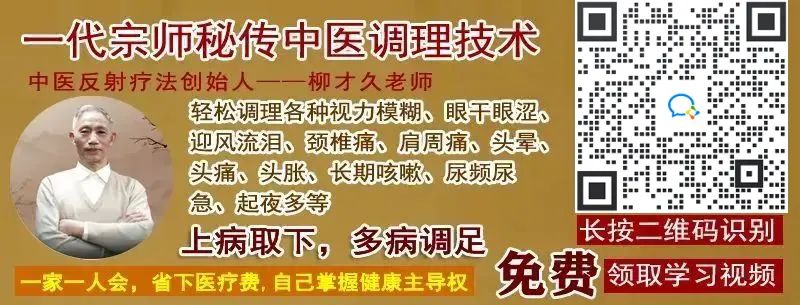
Here is a summary of the common diseases associated with the pathways of the twelve meridians, presented in written form for your reference.
According to the records in the Neijing, although the entire course of the meridians resembles a river flowing into the sea or a lush tree, the most important and emphasized part is the section before the river enters the sea, which corresponds to the roots and trunk of the tree, specifically the areas below the elbow and knee joints. Long-term clinical practice has also proven that the therapeutic effects of the acupoints in this section are often the most prominent along the entire meridian. Below, we will sequentially explore the general pathways and therapeutic knowledge of the twelve meridians.
1Hand Taiyin Lung Meridian——Inner Edge of the Upper Limb
Main Pathway:Tip of the thumb, at the thenar (the junction of the palm and back of the hand), at the Taiyuan (Taiyuan) point (the pulse point at the wrist), at the Chize (Chize) point (the inner side of the elbow near the large muscle on the radial side, close to the thumb side).
Notes from Wujin:When discussing the pathways of the meridians, Wujin often uses acupoints as reference points. Firstly, for practical purposes, the acupoints involved are often major or key points, allowing for a simultaneous understanding of these acupoints while learning the pathways of the meridians; secondly, today’s popular literature on acupuncture is abundant, and online resources about acupoints are readily available, making it easier for us to understand the general direction of the entire meridian.
Wujin emphasizes one point here: as an acupuncturist, the focus of diagnosis and treatment should be more on the “meridian” rather than the “acupoint.” This is not merely a reiteration of the ancient saying “Better to lose the acupoint than the meridian”. The core of this well-known saying in the acupuncture community is centered on “loss,” which is a reluctant choice: selecting acupoints is not easy, but at least the meridian should be correctly chosen. What Wujin emphasizes is that before selecting acupoints, one must first value the guiding significance of the meridian in the diagnosis and treatment of diseases.
Main Diseases Treated:Lung diseases—cough, asthma, sore throat, etc.
Common Disease Reaction Areas:① Below the Chize point where the muscles are thick; ② Near the thenar where the muscles are thick.
Notes from Wujin:Wujin discusses reaction areas rather than specific points because it is often difficult to pinpoint the exact location of a point as described in textbooks. The so-called point can often vary up or down, depending on the person, time, and condition, making precise measurement challenging. The so-called area may seem vague and hard to grasp, but in fact, various shifting points often lie within this area. When we are dealing with a living person rather than a machine or a piece of furniture, we often find that scientific precision does not necessarily yield more “scientific” results compared to sensitive perception.
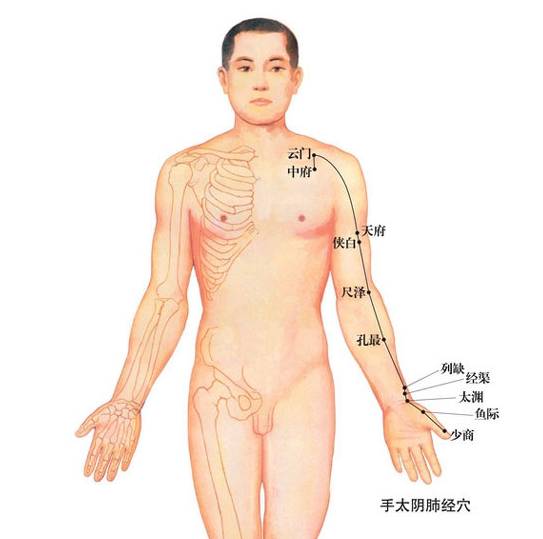
When lung diseases occur, these two areas can easily show abnormal reactions. Tenderness is most commonly observed in the Chize and thenar areas. In acute cases, significant tenderness often appears below the Chize point; in chronic lung diseases, hardening or cord-like structures may often be felt along the lung meridian below the Chize point, accompanied by tenderness; in cases of insufficient lung yang and excessive cold evil, prominent blue veins may often be seen near the thenar.
Most Common Treatment Areas:
① Lieque (Lieque) point: remarkable effect in stopping cough.
② Sensitive points in the Chize area: key acupoints for treating lung diseases.
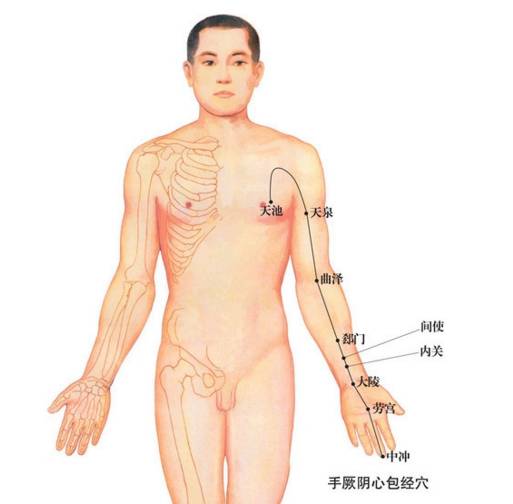
2
Hand Jueyin Pericardium Meridian——Inner Midline of the Upper Limb
Main Pathway:Tip of the middle finger, midline of the palm, midpoint of the wrist crease, two tendons seen above the wrist, and the inner side of the elbow tendon near the little finger side.
Main Diseases Treated:① Heart diseases—chest pain, chest obstruction; ② Stomach diseases—stomach pain, vomiting.
Most Common Treatment Areas:Neiguan (Neiguan) point—key acupoint for treating heart diseases; massaging the Neiguan point can remarkably alleviate motion sickness.

3
Hand Shaoyin Heart Meridian——Inner Back Edge of the Upper Limb
Main Pathway:Tip of the little finger, at the Shenmen (Shenmen) point (the ulnar side of the wrist crease), at the Shaohai (Shaohai) point (at the inner end of the elbow crease).
Main Diseases Treated:This meridian is less commonly applied in clinical practice, with limited experience shared.
Notes from Wujin:The Ling Shu states, “The Hand Shaoyin Meridian has no acupoints”, because “The heart is the master of the five organs and six bowels, the place where the spirit resides, its organ is solid, and evil cannot easily invade it.” This means that evil qi does not easily reach the heart. But what if it does? “If it stays, it harms the heart; if the heart is harmed, the spirit departs; if the spirit departs, death ensues.” If evil qi lingers in the heart, then life is at an end. “Thus, all evils in the heart are actually in the pericardium.” Hence, the saying “the pericardium takes on the evil of the heart.” In today’s acupuncture practice, when heart issues arise, treatment is often more focused on the Hand Jueyin Meridian. This view, influenced by my esteemed mentor, Brother Yushi, emphasizes that the heart is the sovereign and should not be recklessly disturbed.
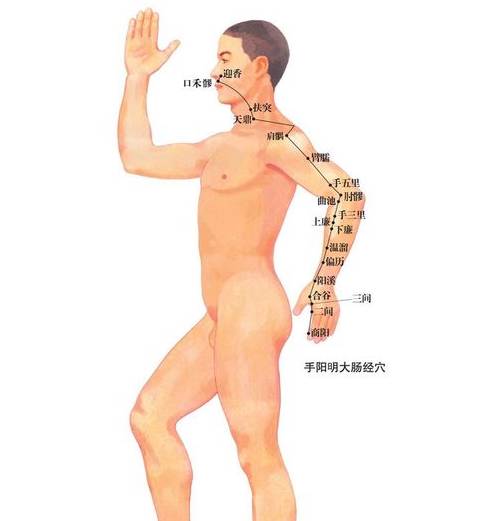
4
Hand Yangming Large Intestine Meridian——Outer Edge of the Upper Limb
Main Pathway:Tip of the index finger, at the Hegu (Hegu) point, at the Yangxi (Yangxi) point (the depression between the two tendons behind the thumb), at the Quchi (Quchi) point (the outer end of the elbow crease).
Main Diseases Treated:① Various diseases of the head and facial orifices (mainly mouth and nose); ② Skin rashes.
Common Disease Reaction Areas:① Below the Quchi point where the muscles are thick; ② At the Hegu point where the muscles are thick.
Notes from Wujin:The area below the Quchi point (around the Shanzhong point) can be used to assess the severity of diseases in the upper body, and its application is very broad. This method originates from the teachings of my esteemed mentor, Brother Fuyou, from the World Federation of Acupuncture. The Hegu point is a major acupoint that can be used to assess various painful diseases.
Most Common Treatment Areas:① Hegu—headaches, toothaches, facial paralysis; ② Quchi—key acupoint for releasing exterior heat.
Notes from Wujin:The Hegu point has a very broad range of treatments; in addition to the common diseases of the head and face mentioned above, Hegu is also a key acupoint for treating various pains throughout the body, for releasing exterior heat, and for regulating abnormal sweating. Given its extensive range of treatments, could it not be considered a panacea? Regardless of the disease, one could just select this point. However, the actual basis for selecting Hegu in clinical practice is still based on the presence of abnormal reactions in the local area. Although it is indicated for certain diseases, if there are no responses at the Hegu point, the effect will not be very significant. This “response selection” concept has been greatly influenced by my mentor, Teacher Zuo Changbo from Guangzhou.
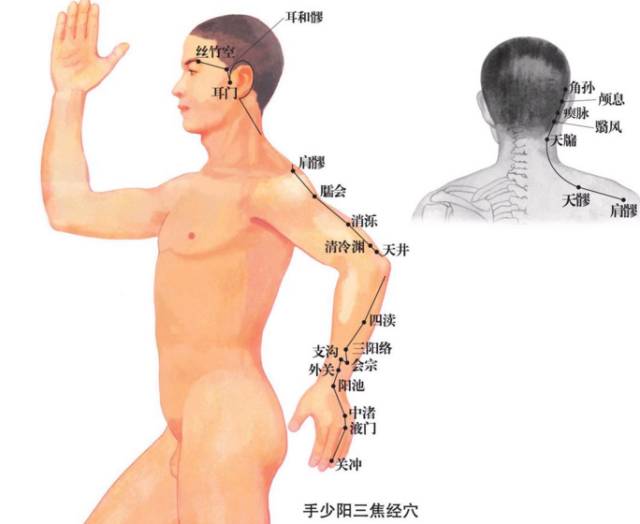
5
Hand Shaoyang Sanjiao Meridian——Outer Midline of the Upper Limb
Main Pathway:Tip of the ring finger, at the ulnar side of the ring finger, at the Yangchi (Yangchi) point (the depression above the wrist crease between the little finger and ring finger), along the outer midline of the arm.
Main Diseases Treated:① Ear diseases—deafness, tinnitus; ② Diseases on both sides of the head—migraine, external eye corner erosion, jaw joint pain; ③ Pain in the hypochondrium.
Most Common Treatment Areas:Wai Guan (Wai Guan) point (2 inches above the midpoint of the wrist crease)—representative point of the Hand Shaoyang Meridian.
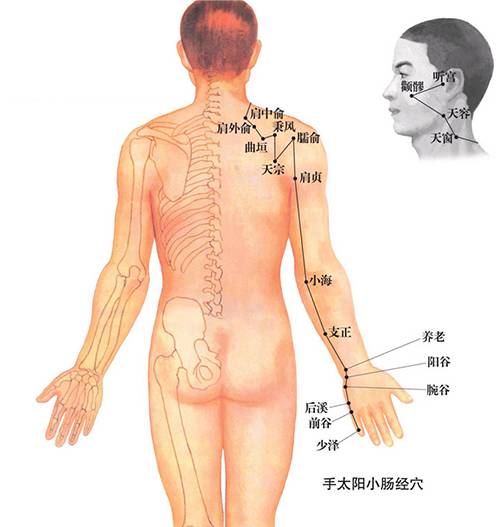
6
Hand Taiyang Small Intestine Meridian——Outer Back Edge of the Upper Limb
Main Pathway:Tip of the little finger, at the red-white junction (the junction of the palm and back of the hand), at the ulnar side of the wrist, at the outer side of the elbow between the two bones (commonly known as “numb tendons”).
Main Diseases Treated:① Neck, shoulder, and back diseases—cervical spondylosis (dizziness, neck stiffness, etc.), shoulder periarthritis (mainly posterior shoulder lesions); ② Eye diseases—blurry vision (regardless of the cause).
Most Common Treatment Areas:① Houxi (Houxi) point—key acupoint for treating cervical spondylosis; ② Yanglao (Yanglao) point—key acupoint for treating eye diseases.
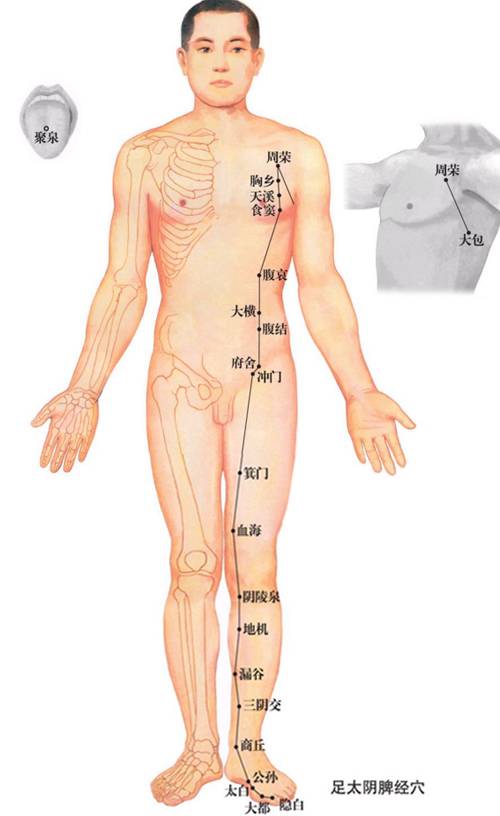
7
Foot Taiyin Spleen Meridian——Inner Midline of the Lower Limb
Main Pathway:Tip of the big toe, at the red-white junction, in front of the inner ankle, along the posterior edge of the tibia.
Notes from Wujin:The pathways of the three yin meridians, especially the Foot Taiyin Spleen Meridian and the Foot Jueyin Liver Meridian, intersect and are complex to remember. Wujin suggests that from a practical clinical perspective, it is sufficient to remember: The Foot Taiyin Spleen Meridian runs along the inner edge of the big toe and the posterior edge of the tibia; the Foot Jueyin Liver Meridian runs between the big toe and the second toe, as well as along the inner surface of the tibia.
Main Diseases Treated:Spleen diseases—diarrhea, abdominal distension, abdominal pain, stomach pain, vomiting.
Common Disease Reaction Areas:① Near the Diji (Diji) point; ② Near the Sanyinjiao (Sanyinjiao) point.
Notes from Wujin:In cases of spleen disease, significant tenderness can often be felt near the Diji point; if spleen deficiency persists, stagnation of dampness may lead to palpable hardening in this area, which can vary in size and serve as a marker for assessing the severity of spleen disease. In cases of both spleen and kidney deficiency, significant tenderness is often observed above and below the Sanyinjiao point. Here, a brief note on the Sanyinjiao point: according to Teacher Huang Longxiang’s research, the “three yin” in Sanyinjiao originally referred to the Foot Taiyin, located 8 cun above the inner ankle; over time, it has evolved to represent the intersection of the three yin meridians, located 3 cun above the inner ankle. This is an academic issue, and Wujin does not wish to dwell on it too much. From clinical observations, it is often seen that pathological reactions occur simultaneously in the area of the Sanyinjiao point, extending forward to the Foot Jueyin Liver Meridian and backward to the Foot Shaoyin Kidney Meridian, rarely occurring in isolation. During treatment, needling from this point, with adjustments in the direction of the needle tip, can easily achieve simultaneous regulation of the other two meridians, yielding satisfactory clinical results.
Most Common Treatment Areas:① Yinlingquan (Yinlingquan) point—key acupoint for spleen diseases; ② Sanyinjiao—key acupoint for regulating the liver, spleen, and kidney.
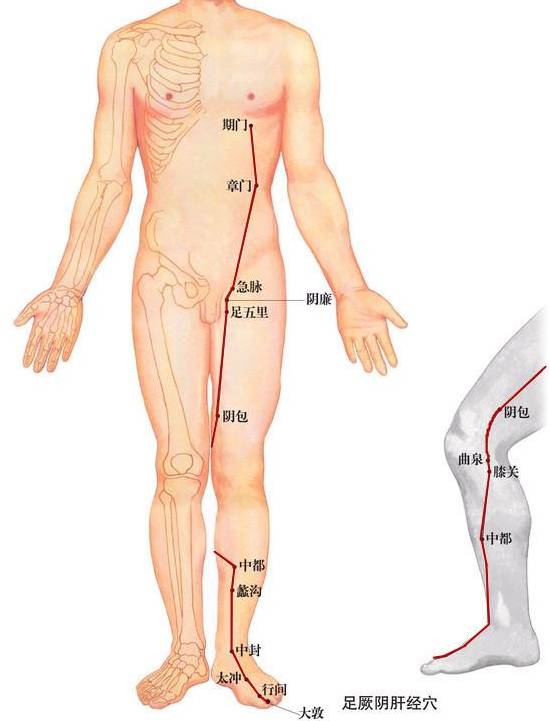
8
Foot Jueyin Liver Meridian——Inner Front (Middle) Edge of the Lower Limb
Main Pathway:Tip of the big toe, between the big toe and the second toe, along the inner surface of the tibia, and at the point 8 cun above the inner ankle where it intersects with the Foot Taiyin Meridian.
Notes from Wujin:According to the Ling Shu, the Foot Jueyin Meridian turns forward 8 cun above the inner ankle and does not continue along the surface of the tibia. However, from Wujin’s clinical observations, the chances of abnormal reactions occurring above 8 cun are relatively low, and if issues arise, they can often be effectively treated from this meridian. Therefore, it is more practical to understand the pathway of the Foot Jueyin Meridian as running along the midline of the tibia.
Main Diseases Treated:① Anterior genital diseases—hernia, urinary abnormalities; ② Gynecological diseases—menstrual and leukorrhea abnormalities; ③ Liver diseases—any issues related to the liver in the differentiation of organs and bowels can often be treated from this meridian.
Common Disease Reaction Areas:① Taichong (Taichong) point area; ② On the inner surface of the tibia (lower segment).
Notes from Wujin:Individuals with long-term liver qi stagnation may feel significant cord-like structures at the Taichong point, which can become enlarged after emotional distress. Additionally, in the vicinity of the Diji point, hardening may occur in cases of long-term spleen disease, which can also significantly amplify after emotional distress. In cases of both liver and spleen deficiency, tenderness is often very pronounced in the lower segment of the tibia.
Most Common Treatment Areas:Taichong—key acupoint for regulating the liver.
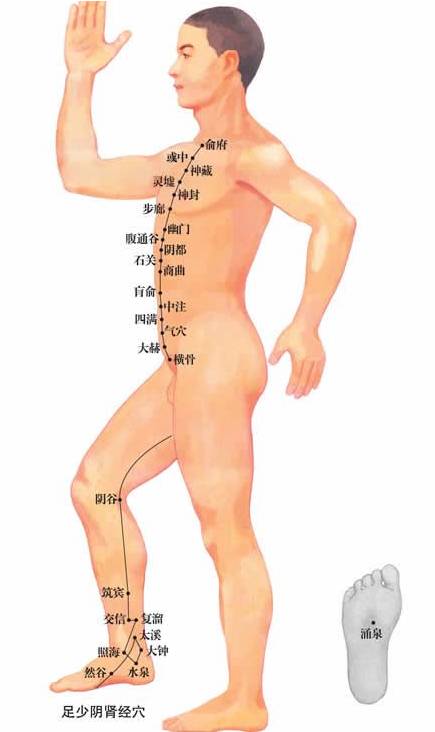
9
Foot Shaoyin Kidney Meridian——Inner Back Edge of the Lower Limb
Main Pathway:At the Yongquan (Yongquan) point (the depression at the front of the foot), below the inner ankle, at the Taixi (Taixi) point (behind the inner ankle), and straight up to the knee joint.
Main Diseases Treated:① Kidney diseases—edema, urinary abnormalities, low back pain, etc.; ② Male diseases—impotence, premature ejaculation; ③ Gynecological diseases.
Notes from Wujin:In fact, the range of diseases that the Kidney Meridian can treat extends far beyond this. From cough, asthma, and dry throat to abdominal distension, diarrhea, and constipation, the acupoints of the Kidney Meridian can be effective. The esteemed acupuncture master Zhang Shijie from Beijing has achieved remarkable results using the Taixi point for almost all body parts and systems, with the disease resolving with the needle, leaving one in awe. So, as a beginner, how should one grasp the selection of acupoints? Teacher Zuo Changbo once mentioned a principle that Wujin recommends for everyone as inspiration: “Where there is disease, there is a sign; where there is a sign, there is a response; where there is a response, there is verification.”
Common Disease Reaction Areas:Areas above and below the inner ankle.
Notes from Wujin:Individuals with kidney deficiency often show significant depressions at the back of the inner ankle (Taixi point) that are deeper and larger than normal, and pressing on them can be painful. The area above the inner ankle often shows reactive responses in conjunction with the Foot Taiyin and Foot Jueyin meridians, indicating simultaneous disease in all three meridians. The area below the inner ankle is also an important site for assessing kidney disease, where significant tenderness can be observed in cases of kidney deficiency.
Most Common Treatment Areas:Taixi—key acupoint for regulating the kidneys.
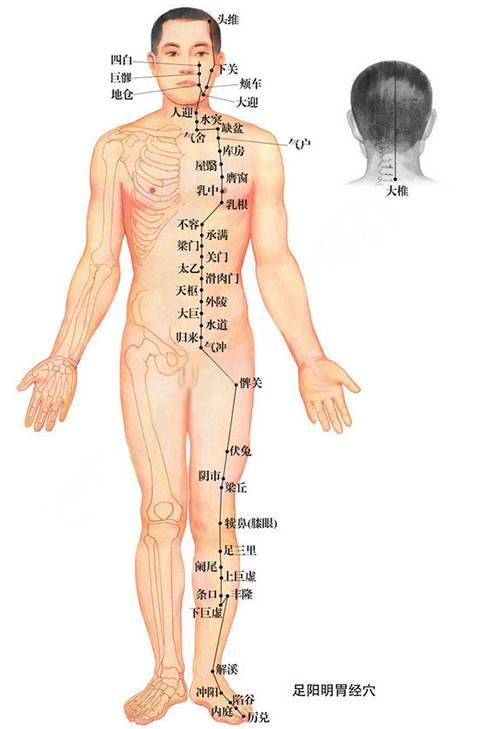
10
Foot Yangming Stomach Meridian——Outer Front Edge of the Lower Limb (Anterior)
Main Pathway:Tip of the second toe, between the second and third toes, at the midpoint of the ankle joint, along the front of the lower leg, at the Zusanli (Zusanli) point (3 cun below the outer knee joint), and at the outer knee joint.
Main Diseases Treated:① Diseases of the head and facial orifices (especially mouth and nose)—dry pain in the nose, oral ulcers; ② Gastrointestinal diseases—stomach pain, vomiting, abdominal distension, diarrhea, constipation.
Notes from Wujin:It is likely that some friends may have questions here: both the Foot Taiyin and Foot Yangming can treat issues related to the spleen and stomach; how should one choose between the two? Consider it a thought exercise to stimulate your thinking.
Common Disease Reaction Areas:Areas near the Zusanli point where the muscles are thick.
Most Common Treatment Areas:Areas with significant tenderness near the Zusanli point.
Notes from Wujin:Are acupoints dead or alive? This interesting question can be well answered through the Zusanli point. According to the standard method of locating acupoints, the Zusanli point should be located 3 cun below the outer knee joint. However, in clinical practice, we often find that the sensitive points reported by patients can vary in position, being higher or lower, more inward or outward; depending on the patient’s condition and disease, the location and depth of needling should also vary.
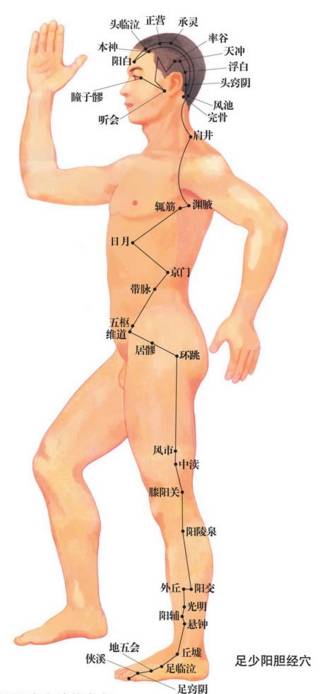
11
Foot Shaoyang Gallbladder Meridian——Outer Midline of the Lower Limb (Lateral)
Main Pathway:Tip of the fourth toe, between the fourth and fifth toes, in front of the outer ankle, along the midline of the lower leg, at the Yanglingquan (Yanglingquan) point (below the knee joint, in front of the large bone).
Main Diseases Treated:Same as the Hand Shaoyang Meridian.
Common Disease Reaction Areas:① Below the Yanglingquan point; ② Near the Juegu (Juegu) point (also known as Xuanzhong, opposite the Sanyinjiao, on the outer side of the lower leg, 3 cun above the outer ankle).
Most Common Treatment Areas:① Yanglingquan—key acupoint for soothing the liver and gallbladder; ② Zuliqiao (Zuliqiao)—key acupoint for eye and ear diseases.
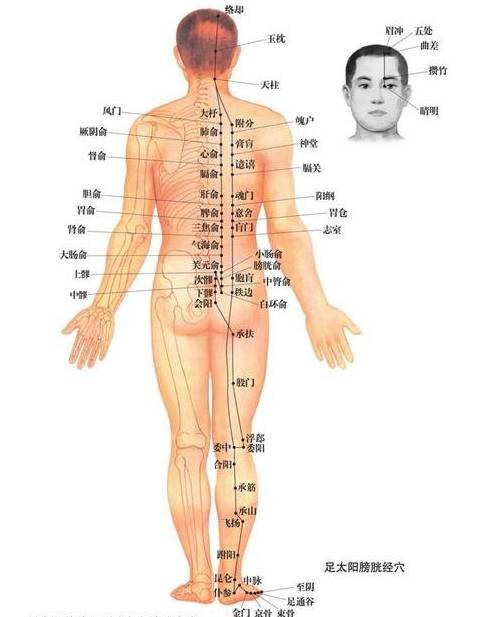
12
Foot Taiyang Bladder Meridian——Outer Back Edge of the Lower Limb (Posterior)
Main Pathway:Tip of the little toe, at the red-white junction, at the Kunlun (Kunlun) point (behind the outer ankle), along the back of the lower leg, at the Weizhong (Weizhong) point (at the midpoint of the popliteal crease).
Main Diseases Treated:① Diseases of the back—headaches, neck and back pain, low back pain; ② Urinary abnormalities; ③ Hemorrhoids.
Notes from Wujin:The Foot Taiyang Meridian is most closely related to the back of the body and is often the main meridian for treating cervical and lumbar diseases.
Common Disease Reaction Areas:① Weizhong point area; ② Around the Chengshan (Chengshan) point (middle of the back of the lower leg); ③ Below the outer ankle.
Notes from Wujin:In today’s society, the immense pressure of development is shared by everyone, leading to conditions like cervical and lumbar diseases occurring early in young people, even adolescents. Thus, the Foot Taiyang Meridian becomes very important. Based on Wujin’s clinical observations, modern individuals often experience pain in the three areas mentioned above along the Foot Taiyang Meridian, and acupuncture and massage treatments in these areas can effectively alleviate the suffering from cervical and lumbar diseases.
Most Common Treatment Areas:① Weizhong—key acupoint for treating low back pain and urinary abnormalities; ② Kunlun—key acupoint for treating head and neck diseases.
The twelve meridians below the elbow and knee joints function similarly to rivers, as described above.


